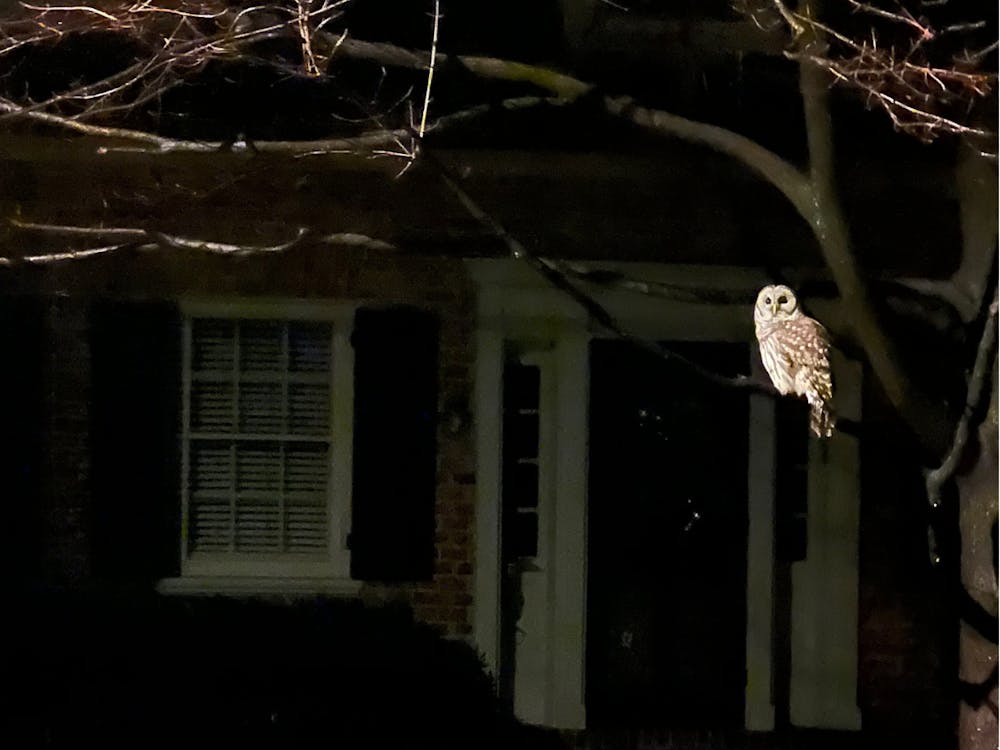A month after a capture-and-release trap set by the United State Department of Agriculture was tampered with, the owl that has attacked over 20 community members has still not been caught.
Since the start of the fall semester, there has been an increase in owl attacks across the University of Richmond’s campus. Campus and community members alike have reported their experiences with the owl, typically attacking early in the morning or after dusk.
Before the owl was released by a person tampering with a capture-and-release trap, the USDA was running two traps, said Chad Forehand, a staff wildlife biologist with the USDA.
“The [trap] the animal was released from was damaged,” Forehand said. “Two pins were removed from the cage in a place where the animal could not access.”
The trap currently being used on campus is called a Swedish-Goshawk trap; it is one of the more common life capture traps used to capture owls and raptors, Forehand said. These traps can range anywhere from $600 to $900, Forehand said.
A Swedish-Goshawk trap has an “A” frame made of metal or wood with chicken wire around it, with springs that pull the doors closed, according to the USDA website.
When an owl drops down onto the perch located in the trap, the springs will close the doors, safely trapping the owl inside, Forehand said.
“The trap uses live bait,” Forehand said. “In the bottom of the trap is a live pigeon the owl is unable to get to.”
The capture could now take longer than the first time as the captured owl might be a little trap-shy, Forehand said.
Enjoy what you're reading?
Signup for our newsletter
Forehand is currently working with manufacturers to get the right parts to fix the trap that was tampered with as the USDA is now only working with one trap, he said.
It is a federal and state offense to tamper with a federal trap, Forehand said. Virginia law 4VAC15-40-160 states that it is unlawful to willfully molest, damage or remove any trap, or any lawfully caught bird or animal in said trap, or in any way disturb traps or snares legally set by another person.
“We are working with [the University of Richmond Police Department], and they are handling the person who tampered with the trap,” Sunni Brown, director of media and public relations, wrote in an email to the Collegian.
URPD did not respond to The Collegian’s request to comment on the investigation nor is the investigation on the crime log.
“We could not identify the individual who illegally tampered with the trap,” Brown said.
After the owl is caught in the trap, the USDA will move it at least 30 miles west as animals that are relocated at that distance are less likely to return, Forehand said.
“We’ll release it somewhere remote or rural, so it doesn’t mess with people,” Forehand said.
The University of Richmond is working with wildlife experts to figure out how to best protect the community and safely relocate the bird, Brown said.
“What we’re doing is coming at night and putting the trap out,” Forehand said. “We then come get it in the morning to make sure we don’t trap other raptors.”
Senior Nolan Sykes, one of the students who has been attacked by an owl, said he was fine with UR relocating the owl.
“My thinking is that at the very least, that if it’s still attacking people, it’s a liability,” Sykes said.
Senior Ilana Lavine said she was attacked the morning of Oct. 19.
“It’s talon grabbed my ponytail and poke my head,” Lavine said. “It drew blood.”
Lavine went to the emergency room later that day because of the pounding headache that started after she was attacked.
“They’re monitoring me for minor concussions,” Lavine said, “That owl is ruthless.”
Forehand hopes that with how aggressive the owl is, they are able to catch it quickly.
It is possible it is the same owl that has been attacking students on campus, but there is no way of confirming or denying for certain, Forehand said.
Forehand hopes there is only one owl and that once the USDA catches it, the attacks will stop, he said.
“All wild animals are their own individual animal,” Forehand said. “This owl could have been born late and could be protecting its nest.”
However, Forehand said it was a little late in the year for that behavior to still be going on.
Chemistry professor Michael Leopold, who has been attacked twice, said: “If you want the owl to live, please leave it in the trap so it gets a better home!”
Contact news writer Amy Jablonski at amy.jablonski@richmond.edu
Support independent student media
You can make a tax-deductible donation by clicking the button below, which takes you to our secure PayPal account. The page is set up to receive contributions in whatever amount you designate. We look forward to using the money we raise to further our mission of providing honest and accurate information to students, faculty, staff, alumni and others in the general public.
Donate Now



